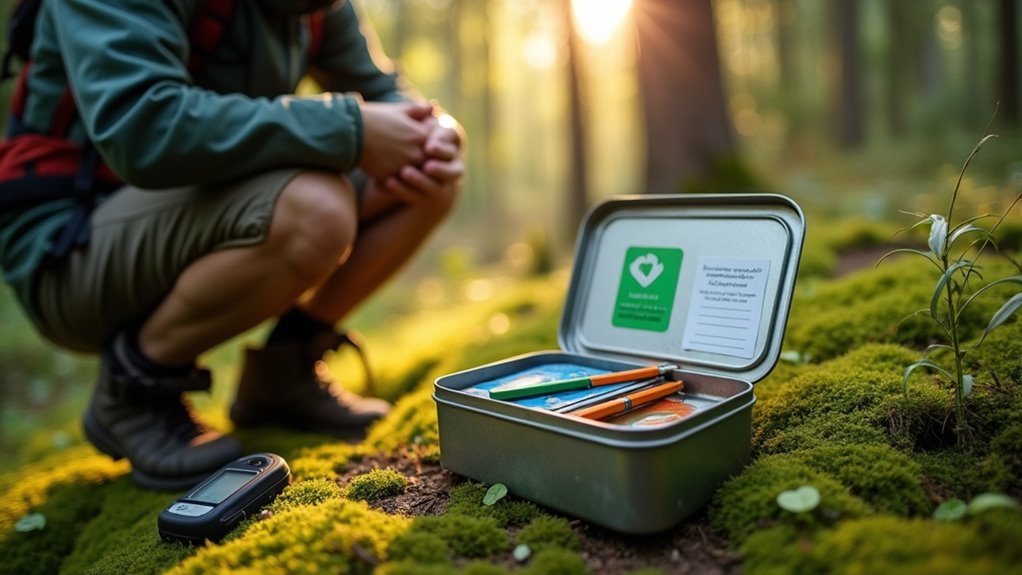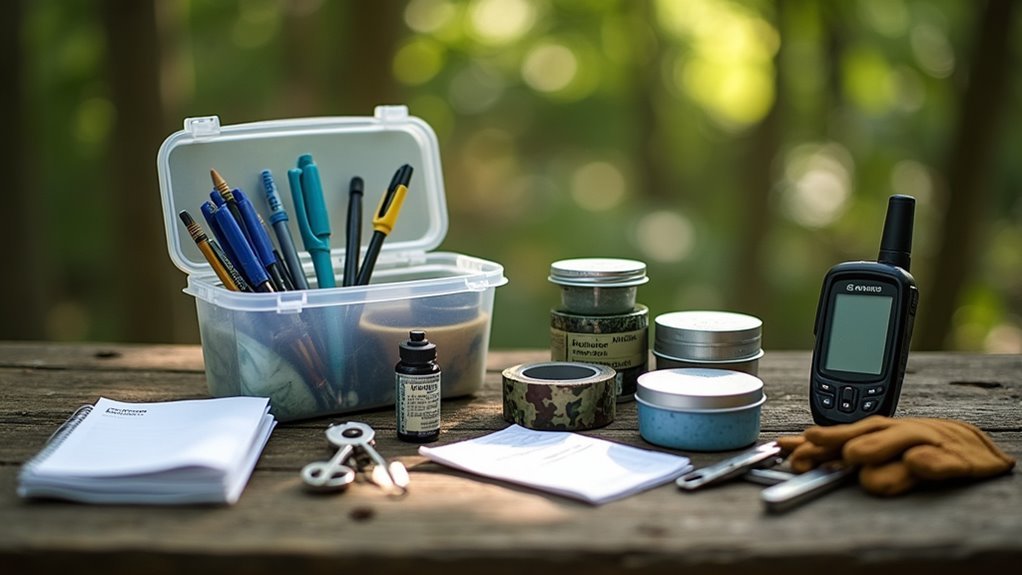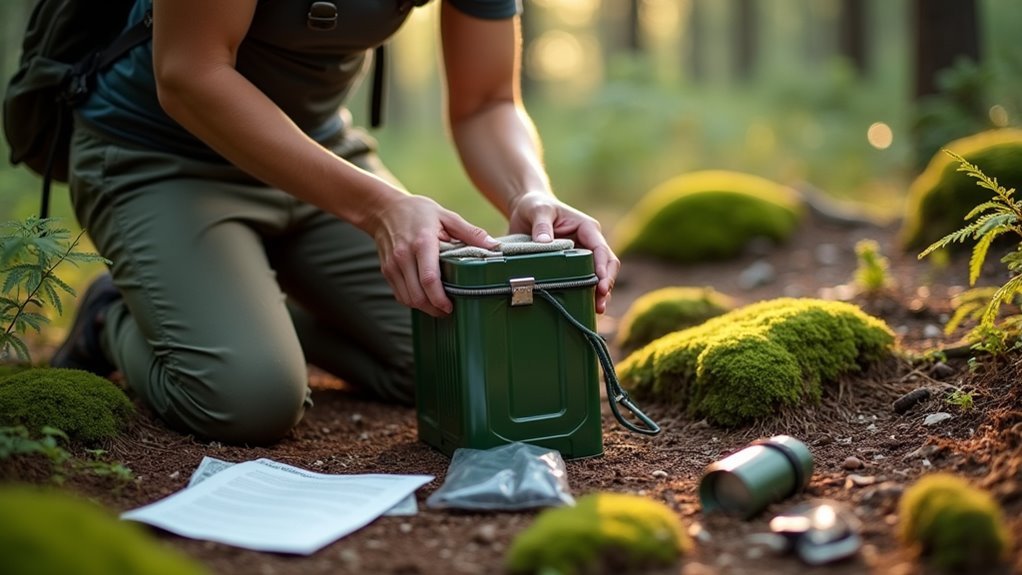Some of the links in this article may be affiliate links. If you make a purchase through these links, we may earn a small commission at no extra cost to you. Thank you.
Have you ever wondered what separates a premium geocache from one that gets archived due to neglect? I’ve been maintaining caches for over a decade, and I’ve learned that regular upkeep isn’t just good etiquette—it’s essential for the game. From waterlogged logbooks to missing containers, the issues that plague neglected caches can be easily prevented with some simple habits and the right supplies. Let me share what works.
Understanding the Cache Health Score System

A key aspect of maintaining your geocaches is understanding how the Health Score system works behind the scenes.
This hidden metric basically monitors your cache’s well-being through logs and other factors.
I’ve found that the algorithm doesn’t care about your cache’s difficulty level—even a D5 cache can trigger alerts after just a few DNFs!
When your cache’s Health Score drops too low, you’ll receive an automatic email prompting you to check on it.
This typically happens after multiple “Did Not Find” logs or “Needs Maintenance” reports.
If you ignore these warnings, well, community reviewers might eventually include your cache in their sweeping process.
In my experience, staying proactive about maintenance saves a lot of headaches later.
Monitoring Logs and Community Feedback
I’ve found that checking your cache logs regularly is like taking your geocaching pulse—you’ll know immediately when something needs attention.
Setting up email notifications for new logs gives you real-time feedback on your cache’s health, whether it’s praise from happy finders or alerts about potential issues that need fixing.
In my experience, paying close attention to different log types—especially those DNFs or Needs Maintenance reports—can save you from the embarrassment of having your cache temporarily disabled by HQ.
Log Types Matter
Why do geocachers need to understand log types? Well, they’re not just digital formalities—they’re essential communication tools that keep our geocaching community thriving. When I post a DNF after thoroughly searching coordinates, I’m actually alerting the owner that something might be wrong. Similarly, when I drop off a trackable, a Write Note log helps its owner follow its journey.
| Log Type | When to Use | Why It Matters |
|---|---|---|
| Needs Maintenance | Wet logbook, container damage | Alerts owner to specific problems |
| DNF | After thorough search | Signals potential cache issues |
| Owner Maintenance | After fixing issues | Removes “attention needed” flag |
Notification Strategies
How do you stay on top of what’s happening with your geocaches?
I’ve found that setting up email notifications for each log is like having my own surveillance system. Whenever someone posts a log, an emails alert owners immediately, which I think is invaluable for quick responses.
Your cache has a hidden Health Score that actually tracks its condition behind the scenes.
When this Health Score drops below a certain threshold, an automatic email is sent to nudge you into action. I’ve seen cases where, hmm, maybe just 2-3 DNFs on a difficult cache triggered notifications.
Don’t forget to regularly check your cache page too! Community feedback through Needs Maintenance or DNF logs often contains specific details about issues like wet logbooks or missing items that a low Health Score alone doesn’t explain.
Essential Maintenance Supplies for Field Visits

I’ve found that packing the right supplies can make or break my cache maintenance visits, especially in challenging weather.
You’ll want to carry my waterproofing essentials like silicone sealant and ziplock bags, along with replacement options including various container sizes and magnetic backups.
Don’t forget a complete logbook care kit with extra logs, pens, and those tiny pencils that’ll keep your cache visitor-ready even when you find unexpected issues.
WATERPROOFING ESSENTIALS
Securing your geocache against water damage starts with packing the right supplies before you ever leave home.
During regular maintenance, you might need to check if your cache container is damaged by moisture.
I’ve learned that to make sure that your geocache stays dry, you’ll want to make sure you’ve got these essentials in your kit:
- Extra waterproof logbooks to replace soggy ones on the spot
- Magnetized tins that provide instant waterproof container solutions
- Sealants to repair or enhance existing container waterproofing
- Protective covers that add an extra layer of water resistance
- Verification tools to test if containers are actually waterproof
In my experience, geocaches in rainy areas need more frequent logbook replacements—every couple months is a good rule of thumb.
Water damage happens fast, so being prepared saves your cache!
REPLACEMENT CONTAINER OPTIONS
While waterproofing protects your cache contents, sometimes the container itself needs replacing. I’ve learned cache maintenance is most efficient when I’m prepared with backup options. When I discover a damaged cache during my maintenance sweeps, having replacement containers on hand saves me a return trip.
| Container Type | Best For | Durability | Installation Ease |
|---|---|---|---|
| Magnetized Tins | Metal surfaces | Medium | Very easy |
| Waterproof Tubs | Woodland areas | High | Moderate |
| Micro Containers | Urban caches | Medium | Easy |
| Ammo Cans | Harsh environments | Very high | More difficult |
You know about cache maintenance basics, but actually carrying various container sizes helps match the original difficulty level. I think geocache owners should prioritize having at least two backup containers ready—preferably waterproof tins or something similar that’ll protect contents from our unpredictable weather patterns.
LOGBOOK CARE KIT
Every geocacher should assemble a detailed logbook care kit for their maintenance visits.
When you get that dreaded “cache needs owner attention” note, you’ll be prepared!
In my experience, Learncache maintenance is both important (and required) for responsible geocaching.
I’ve found that having a combination of logs and circumstances-appropriate supplies saves countless headaches.
Here’s what I pack in my kit:
- Extra logbooks for routine or emergency replacements
- Log sheets for cachers to sign, especially in rainy areas
- Waterproof containers to protect replacement logs
- Backup papers for quick logbook repairs
- Inspection tools to verify log condition
Trust me, you’ll feel like a geocaching superhero when you can immediately replace a soaked logbook during your field visits!
Physical Inspections and Container Care

Regular physical inspections form the backbone of effective geocache maintenance. When I visit my caches, I always head straight to the posted coordinates to find the cache and check for issues. If your cache’s Health Score may indicate problems, don’t delay your visit. I’ve learned that owners that might temporarily disable the cache should inform seekers who are exploring the area.
I carry this essential kit during inspections:
| Item | Purpose | Replacement Frequency |
|---|---|---|
| Backup containers | Immediate replacement | As needed |
| Dry logbooks | Replace wet ones | Every 3-6 months |
| Fresh SWAG | Enhance experience | When depleted |
Remember to check your trackable inventory during each visit. In my experience, containers often need attention before they show obvious signs of wear – it’s better to be proactive than sorry!
Managing Trackables and Cache Contents
The management of trackables deserves special attention in your geocaching routine.
When a geocache has a hidden trackable, it’s essential to monitor its status.
According to the Community Manager at Geocaching, regular inventory checks prevent confusion when something is sent to the cache but isn’t actually there.
The Help Center suggests that a geocache is a reward in itself, but well-maintained contents enhance the experience!
During maintenance visits, I recommend:
- Verifying if listed trackables are physically present
- Marking missing trackables in the system immediately
- Replacing wet or waterlogged logbooks without delay
- Swapping out logbooks every couple months, especially in rainy areas
- Inspecting SWAG items to make sure they’re in good condition
If you notice items that indicate that a cache needs attention, don’t wait—act promptly!
Effective Communication With Reviewers and Finders
Why is communication so important in geocaching? Well, it’s the glue that holds our community together, especially when it comes to cache maintenance. I’ve learned that all communication with reviewers should happen directly on the cache page—not through private messages.
This transparency helps reviewers track your activity and makes the process smoother for everyone involved.
When someone reports an issue, I always post my response on the cache page and follow up with maintenance logs. Think of your cache page as a timeline—reviewers rely on it to see if you’re an attentive owner.
Even if a friend helps with maintenance, you should post the Owner Maintenance log yourself. This clear communication with both reviewers and finders shows respect for their time and enhances the geocaching experience for all.
Frequently Asked Questions
How to Properly Maintain a Geocache?
I regularly perform cache inspection, log replacement, and container sealing. I also provide weather protection, maintain site upkeep, and refresh swag. You’ll want to check your cache every few months.
Is Geocaching Still a Thing in 2025?
Yes, geocaching is thriving in 2025! I’ve noticed a popularity surge due to tech impact enhancing the experience. The community vibe remains strong with global spread continuing this hobby revival’s relevance.
What Is a Ghost Geocache?
I’ve seen over 150 ghost caches haunt the system! These abandoned treasures are geocaches that physically exist but aren’t active online—phantom coordinates stuck in limbo when owners can’t properly archive them.
What Does GZ Mean When Geocaching?
In geocaching, GZ means “Ground Zero” – the exact spot where I’m looking for the cache. While GZ’s definition evolved from military origins, it’s now a universal symbol among us geocachers marking our final search location.